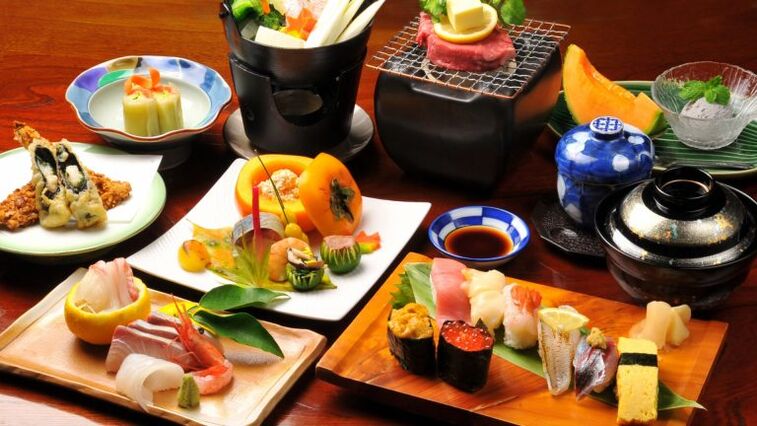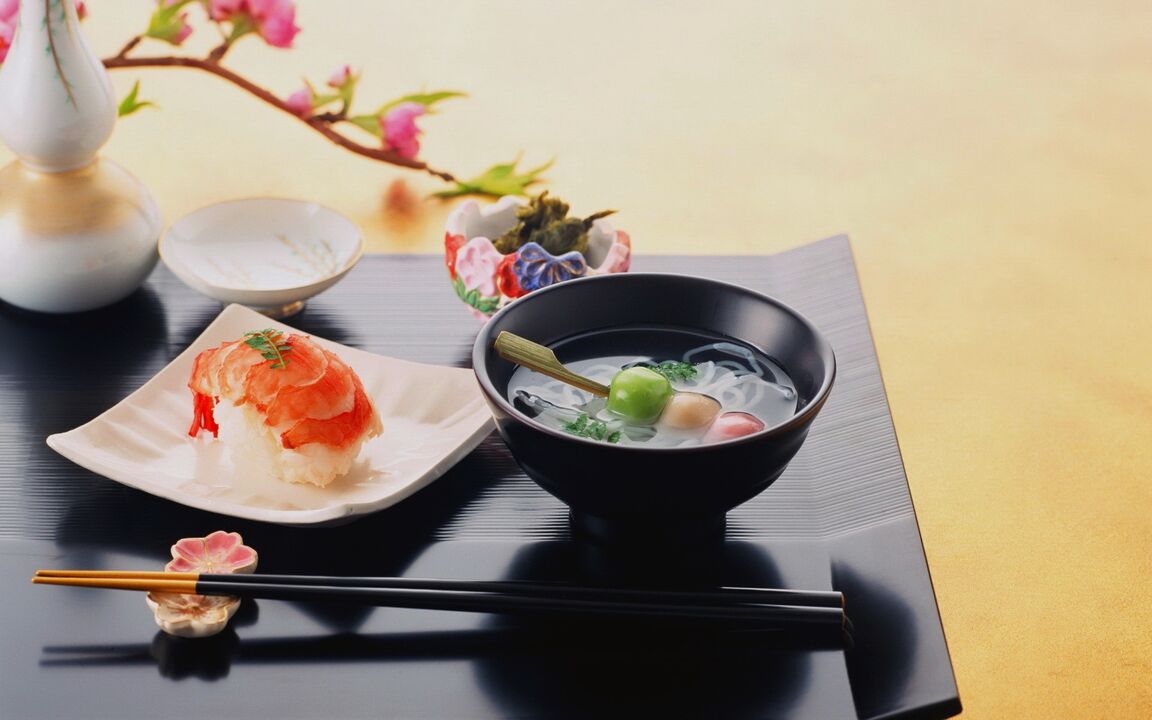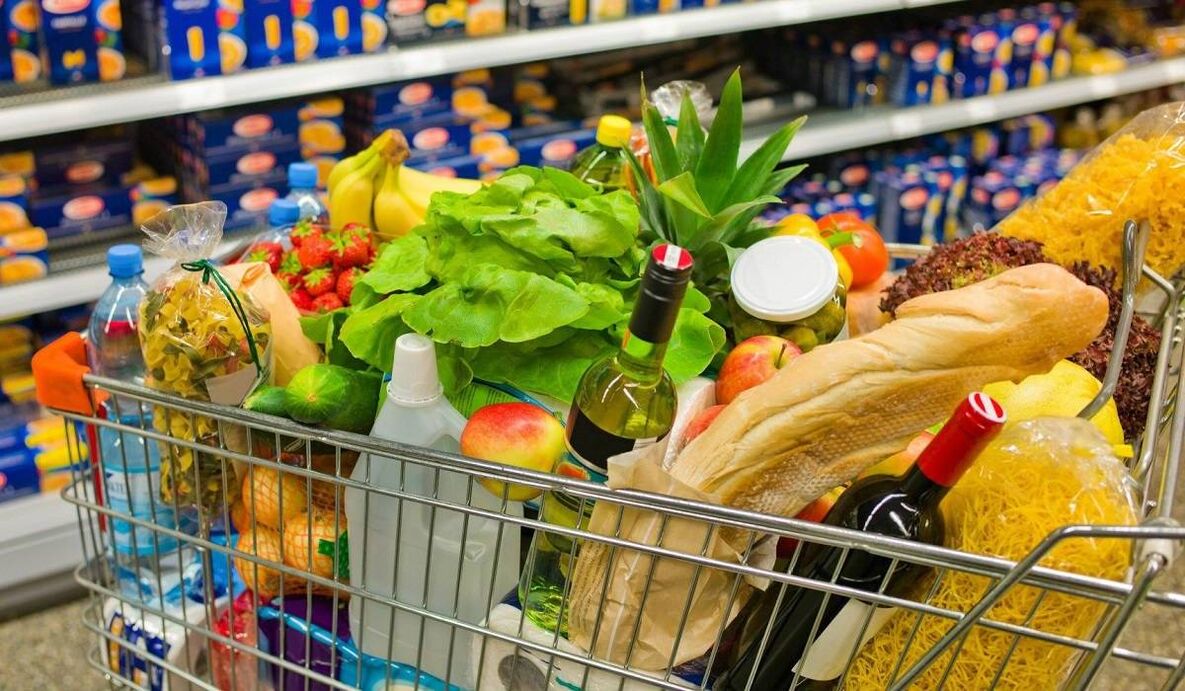In recent years, the Japanese diet has gained tremendous popularity, which simultaneously combines both rapid results and benefits for the body. Moreover, the main feature of this 2-week diet plan is that there is no so-called relapse, when everything returns to the original after 2-3 weeks.
Japanese food is becoming more and more popular thanks to the growing popularity of Japanese cuisine in local cafes and restaurants. In almost every cooking today, you can buy rolls or whatever you need to prepare them yourself. So what is the Japanese diet for weight loss?

The main features of the Japanese diet for 14 days
Let's take a quick look at what the Japanese diet for weight loss is and what principles it is based on:
- The total duration is 14 days;
- Low carb, low carb and high protein foods. Requires discipline and consistency;
- Total cost - no more than 2000 rubles for the whole cycle;
- The estimated result is from 5 to 8 kg;
- Recurrence - no more than twice a year;
- Stability - high, with proper exit from the diet after two weeks, the result continues for a long time and without recurrence;
- Contraindications: pregnancy, breastfeeding, diseases of the gastrointestinal tract (ulcers, gastritis, gastroduodenitis, etc. ), kidney and liver diseases. Also not recommended in the presence of heart problems. Before starting a diet, it is preferable to consult
Japanese diet for weight loss - riding trend or real effectiveness?

The Japanese diet was previously completely unknown. Moreover, the very concept of "diet" meant severe cuts in food and calories, up to and including hunger. Even with the popularization of this unique food plan, many still believe that the Japanese diet for 14 days will consist of sushi, green tea and of course rice. However, this diet should not be judged only by traditional Japanese cuisine, all that will remind you for two weeks is sea fish, eggs and green tea - products that are present in many parts of the world. This is a great advantage of the diet, as the diet will contain familiar foods, without any exotics, that can lead to digestive disorders or even allergies.
It is not yet known exactly how the 14-day Japanese diet relates to the land of the rising Sun. According to some reports, it took place in one of the Japanese clinics, according to others, this diet plan was attributed to Japan because of its strict discipline, menu and effectiveness. However, it is not so important where this diet originates from, as the fact that it is extremely effective and harmless, when treated and respected properly.
As with everything else, the Japanese menu means reducing calories in the diet. It is based on traditional Japanese cuisine, which is famous for its lack of fatty foods, an abundance of vegetables and fish. One of the well-known public figures and nutritionists Naomi Moriyama believes that food is the secret of Japanese women who maintain their beauty and slim figure until old age. The key, she says, are low carbs and small portions.
According to Naomi's calculations, the Japanese consume 25% fewer calories than people in any other country. For example, with an abundance of different foods and even so-called fast foods, chips, chocolate, fatty sweets and even butter are not particularly popular in Japan. Even "street food" is low in calories and low in fat and carbohydrates. Therefore, the Japanese diet menu is fully in line with the food culture, traditions and foundations of the diet in the country.
Proper diet for fat burning is a must! But think about what kind of result do you want to get in the end? Are you sure that after removing the layer of fat, you will see a toned and strong body? To tone your muscles and gain sexual volume, you need the right exercises! And to make it easier for you, we offer a ready-made training plan diagram!
The main concept and rules of the Japanese diet

The sizes of the parts of the inhabitants of the CIS and Japan are markedly different, therefore, for many people, a sharp transition can be a real test. But do not worry, because this plan is designed for two weeks, after which you can slowly return to the usual diet and favorite foods.
Protein will be the basis of your diet and a source of satiety. You can only get it from the following products:
- A fish;
- Eggs;
- Chicken breast;
- Dairy products;
- Lean beef.
Only crackers and some vegetables will go as carbohydrates. For fats - olive oil. Also, fats will be contained in fish and other protein products, this will avoid deficiency. The menu and scheme of the 14-day Japanese diet with a significant calorie restriction, especially carbohydrates, can be a real challenge. However, it is worth noting that the body gets used to such a diet quickly and the second week will not be so difficult.
It is important to note that healthy fiber is present in sufficient quantities in the menu. It is found in vegetables, which can be consumed almost without restrictions (only in a few days). This eliminates any gastrointestinal problems and improves digestion. Green tea and coffee are also included in the diet. They will not only allow you to stay alert and avoid fatigue, but will also provide the body with a large amount of antioxidants. It is important that the tea is natural, colorless and tasteless, and it is preferable to buy coffee beans and grind it yourself.
By looking at the menu for the 14 days of the Japanese diet, you can be sure that all the beneficial substances are present in this diet plan and the major changes have mainly affected the portion size and the amount of food consumed. Basically, two weeks for most people pass without any consequences, but if your body has reacted very harshly to the reduction of carbohydrates, then you should postpone the diet for the future and go to the doctor. The main symptoms for this will be headache, severe weakness and fatigue.
Drinking regimen is of great importance. You should consume plenty of plain water at room temperature. First, it will help improve digestion and cope more easily with hunger by simulating a full stomach. Second, it will allow you to remove protein processing products from the body. Another important point is the strict observance of the general plan. If you decide to seriously try and control how to lose weight on a Japanese diet, then you should consume only those foods and in the amount given for each day. Substitutions are not allowed. You also can not change or rearrange the days.
The only exceptions are coffee and tea. In the morning, instead of coffee, you can drink a cup of tea, depending on personal preference. Of course, no sugar. Salt is also a negative factor in the diet, but if you can not completely eliminate it, then limit yourself to the minimum amount.
One of the main difficulties, in addition to the low calorie content, is also considered the small number of meals per day. While other diets include 5 or even 8 snacks a day, the Japanese diet includes only 3 meals. It is also worth remembering that you should start the day with a glass of water, this will "start" the body and metabolic processes. Dinner should be eaten no earlier than 2-3 hours, so that at bedtime the food has time to be digested.
This is a strict diet, so a quiet introduction is recommended, excluding shortening transitions in the diet. Thus the body will quickly adapt to the new conditions and the diet will be more comfortable. The easiest way to prepare would be to completely stop fast food at least 3-5 days before the start of the diet, as well as cut portions (eat no more than half the usual amount of serving). Although this scheme may seem very rigid, it is completely balanced and does not harm the body, but at the same time allows you to lose 5-8 kg in just 2 weeks.
Preparatory period and food purchases

You will need:
- Coffee (ground or grained) - 1 pack;
- natural green tea - 1 pack;
- Chicken eggs - 20 pieces;
- Lean beef (pulp) - 1 kg;
- Sea fish (fillet) - 2 kg;
- Chicken fillet - 1 kg;
- Extra virgin olive oil - 0, 5 l;
- Carrots - 2-3 kg;
- Cabbage - 2 pieces of medium size;
- Eggplant or zucchini - 1 kg;
- Fruit (any other than grapes and bananas) - 1 kg;
- Kefir - 1 l;
- Tomato juice - 1 l;
- Lemon - 2 pieces.
In terms of dietary principles and lists, the Japanese diet is often compared to and even confused with the "chemical diet" - a diet plan developed in the United States. Its creator is Osama Hamdiy, whose diet is actively used in the treatment of diabetes and obesity. The Japanese diet also uses the principle of a sharp restriction of carbohydrates and an increase in protein intake, due to which the chemistry of metabolic processes in the body changes, causing chains of reactions that lead to a sharp drop in weight. However, there is a significant difference between these meal plans. The Osama Hamdiya system includes an unlimited number of products, which allows you to rely on muscle building and vigorous training. At the same time, the Japanese scheme has a strict quantitative limit and a short period of only two weeks. This is a plus for those who want to get fast results and can not tire the body for months, avoiding the usual diet.
A detailed menu of the Japanese diet for each day

It is important that this scheme is taken very seriously, strictly following the recommendations. Any attempt to break the scheme or add products may result in worse overall results than expected. The menu for each day of the Japanese diet for 14 days is as follows:
Day number 1
- Breakfast - pure coffee without milk or sugar;
- Lunch - boiled eggs (2 pieces), cabbage boiled in olive oil, 1 glass of tomato juice;
- Dinner - 200 g of fried or boiled fish.
Day number 2
- Breakfast - Coffee and 1 slice of rye bread;
- Lunch - 200 g fried or boiled fish with boiled cabbage and olive oil;
- Dinner - 100 g of boiled beef and 1 cup of kefir.
Day number 3
- Breakfast - a slice of rye bread (dry on a toaster) or a biscuit without additives. A cup of coffee;
- Lunch - fry eggplants or zucchini in olive oil (any serving);
- Dinner - boil 200g unsalted beef, fresh cabbage with olive oil, 2 boiled eggs.
Day number 4
- Breakfast - a small fresh carrot with the juice of a lemon;
- Lunch - 200 g fried or boiled fish, 1 glass of tomato juice;
- Dinner - 200 g of fruit (any).
Day number 5
- Breakfast - a medium carrot with the juice of a whole lemon;
- Lunch - boiled or steamed fish with a glass of tomato juice;
- Dinner - 200 grams of fruit (any).
Day number 6
- Breakfast - a cup of coffee without sugar;
- Lunch - boiled chicken without salt (500 g), salad with fresh carrots and cabbage (season with olive oil);
- Dinner - a fresh carrot and 2 boiled eggs.
Day number 7
- Breakfast - a cup of green tea;
- Lunch - boiled beef without salt (200 g);
- Dinner - your choice: 200 gr fruit, 200 gr boiled beef with a glass of kefir, 200 gr boiled fish or 2 boiled eggs with salad (carrots dipped in olive oil.
Day number 8
- Breakfast - a cup of coffee;
- Lunch - 500 g boiled chicken without salt, salad with cabbage and carrots (season with olive oil);
- Dinner - a small carrot with olive oil, 2 boiled eggs.
Day number 9
- Breakfast - a carrot with the juice of a whole lemon;
- Lunch - 200 g of fried or boiled fish and a glass of tomato juice;
- Dinner - 200 g of fruit to your liking.
Day number 10
- Breakfast - a cup of coffee;
- Lunch - 3 small carrots (fried in vegetable oil), 1 egg and 50 g of cheese;
- Dinner - 200 g of each fruit.
Day number 11
- Breakfast - a cup of coffee and 1 slice of rye bread;
- Lunch - fry eggplants or zucchini in olive oil (any amount);
- Dinner - 200 g of boiled beef, fresh cabbage with olive oil, 2 boiled eggs.
Day number 12
- Breakfast - a cup of coffee and a slice of rye bread;
- Lunch - 200 g fried or boiled fish, fresh cabbage with olive oil;
- Dinner - 100 g of boiled beef and 1 cup of kefir.
Day number 13
- Breakfast - a cup of coffee;
- Lunch - 2 boiled eggs, cabbage boiled in olive oil and 1 glass of tomato juice;
- Dinner - fry 200 g of fish in olive oil.
Day number 14
- Breakfast - a cup of coffee;
- Lunch - fried or boiled fish, fresh cabbage with olive oil;
- Dinner - 200 grams of boiled beef, 1 cup of kefir.
There is an opinion that this diet allows you to get more consistent and lasting results without going back to your usual weight. After losing weight, it is possible to maintain weight for up to 3 years, but only on condition that you strictly adhere to the diet and do not start compensating everything with high-calorie foods immediately after the 15th day. Also, a great solution would be to fit the Japanese meal plan into your daily diet.














































